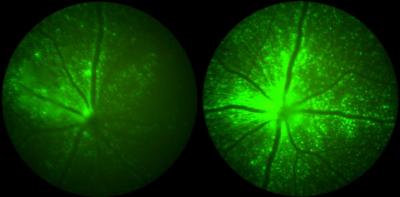
AAVs with TLR9-inhibitory sequences incorporated into their genomes allowed significantly higher expression of a linked fluorescent reporter gene in the mouse retina (right) than AAVs that were lacking the sequences (left) following intravitreal administration. Image credit: David Copland, University of Bristol, UK
An international collaboration of leading groups in gene therapy and vision science, including George Church’s group at Harvard’s Wyss Institute for Biologically Inspired Engineering and Harvard Medical School (HMS) and Constance Cepko’s group at HMS, developed a “coupled immunomodulation” strategy in which short TLR9-inhibitory sequences are incorporated directly into the much longer AAV genome containing therapeutic DNA sequences.
Investigated in different tissues of mice, as well as ocular tissues of pigs and non-human primates, the approach showed broad anti-immunogenic potential. Importantly, the study also highlights that pathways other than TLR9 activation likely contribute to inflammation in the highly immunogenic model of intravitreal AAV injections in macaques. The work is published in Science Translational Medicine.